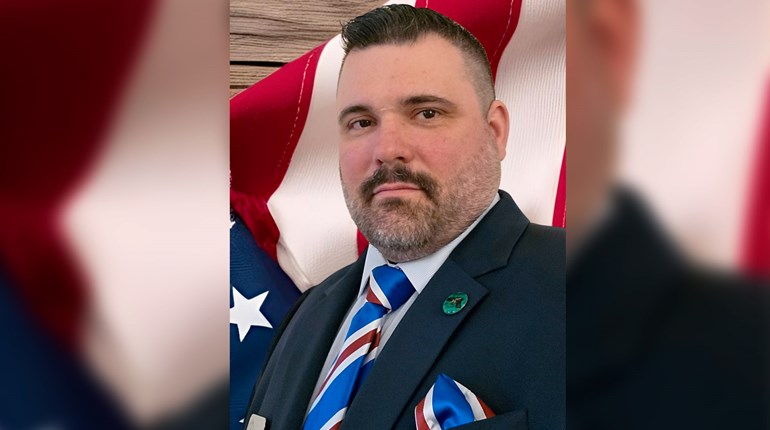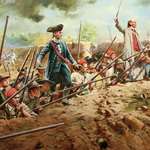The NRA was founded in 1871 to teach Americans to shoot, but over time, as some moved to take away our Second Amendment rights, the NRA also started using the First Amendment to protect the Second. Both of these parts of the NRA’s mission remain critical today.
Who could have guessed in 1871, when the founders of the National Rifle Association incorporated their new group in New York, that the political leaders of the Empire State would dedicate themselves to the association’s destruction a century and a half later? Or that a newly elected president of the United States would pledge even before being sworn into office in 2021 to “defeat” the NRA?
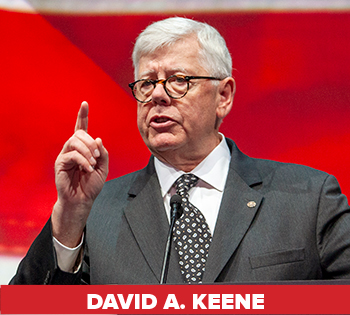 At that time, no one seriously questioned the wisdom of the nation’s Founders for including a guarantee that the new American government would never “infringe” on the right of the people “to keep and bear arms.” Among the first presidents of the newly formed NRA, created just a few years after the end on the nation’s Civil War, were Union general and later U.S. President Ulysses S. Grant, and another of the Union’s greatest generals, Phil Sheridan.
At that time, no one seriously questioned the wisdom of the nation’s Founders for including a guarantee that the new American government would never “infringe” on the right of the people “to keep and bear arms.” Among the first presidents of the newly formed NRA, created just a few years after the end on the nation’s Civil War, were Union general and later U.S. President Ulysses S. Grant, and another of the Union’s greatest generals, Phil Sheridan.
They were concerned that too many of their mostly urban fellow citizens were losing the familiarity with firearms that was a part of the American character and the nation’s cultural heritage. The new association fostered firearms competence, ran competitive matches and provided technical information and safety training to all. For nearly a century, these were the primary functions of the NRA. Generations of Americans became familiar with firearms and the shooting sports through NRA programs.
A century later, after President John F. Kennedy (an NRA member like nine other U.S. presidents) was assassinated, the world began to change. The Second Amendment became the most controversial of all stated natural rights.
Opposition to the private ownership and even the manufacture of firearms began to grow, and by the end of the decade, gun owners were on the defensive, facing a well-organized and lavishly financed movement dedicated to first registering and then restricting firearms ownership, with an eventual goal of creating what they liked to call a “gun-free society.” Gun owners began to be demonized as a bloodthirsty band of rednecks, ignorant know-nothings and potentially dangerous extremists. Firearms were purported to be the cause of crime, mass shootings and all urban violence. Anti-gun “intellectuals” argued that the Second Amendment didn’t mean what it said; that it was an outdated guarantee of rights inconsistent with a modern society. Some even claimed the U.S. Constitution, and the U.S. Bill of Rights within it, were unworkable in today’s world.
With a quasi-religious fervor, many came to believe that by restricting or even banning firearms, we could create a crime- and violence-free society the likes of which the world has never seen.
Former UN Ambassador and National Security Advisor John Bolton wrote in a foreward to my book on the Second Amendment, Shall Not Be Infringed, that these gun-banners reminded him of the activists that led the anti-nuclear movement of the 1970s and 80s. They were persuaded that if our country would just unilaterally disarm, our adversaries would lay down their arms, and world peace would follow. Those who today blame crime and violence not on criminals, but on the firearms they misuse, are, he suggested, equally delusional.
By 1968, the anti-Second Amendment movement persuaded then-President Lyndon B. Johnson and the Democrat Congressional leadership of the day to enact the Gun Control Act of 1968, which Sen. Edward M. Kennedy (D-Mass.) declared a “good first step” on the road to a gun-free society. Leaders of both political parties seemed ready to travel that road.
Though the NRA’s founders could not have imagined a serious effort to abolish the private ownership of firearms in this country, by the organization’s centennial, many NRA members and friends believed that those sworn to denying Americans their Second Amendment rights were not only increasing, but that there was a real danger they would achieve their goal.
When Richard Nixon became president in 1969, he formed a commission to look at additional firearms restrictions. That commission recommended that the nation should, within 10 years, outlaw the sale, manufacture or private possession of handguns. The organization that would become the Bureau of Alcohol, Tobacco, Firearms and Explosives (ATF) and the U.S. Department of Justice began arresting gun collectors and others whom they deemed had violated the new, draconian and often vague laws affecting firearms owners passed in ‘68.
Up until then, the NRA was mostly non-political. While the U.S. Congress and various presidential administrations sometimes asked NRA officials for their opinions on issues of interest to voters, the association did not lobby, endorse candidates or involve itself in political campaigns. By the late 1960s, however, with the advent of what has come to be known as the “culture wars,” it was becoming clear to NRA leaders, members and friendly elected officials that many politicians were prepared to not only “infringe” on the rights the Founders considered sacrosanct, but ultimately to abolish them altogether.
The NRA and its members were awakening to this new threat, and, within a few years, the organization emerged as the nation’s foremost defender of the Second Amendment. The NRA’s Institute for Legislative Action (ILA) was formed in 1975 and began “grading” political candidates of both parties on their support of Second Amendment rights and putting together what has been described by experts as one of the most-effective lobbying operations in U.S. history. The NRA quickly moved from non-involvement to advocacy—endorsing candidates of both parties who were willing to stand up for the Second Amendment.
Unlike members or supporters of most “advocacy” or issue groups, NRA members proved willing to cross party lines to support candidates who share their values. A lifelong Republican in a district represented by a Republican running against a Democrat opponent demonstrably more dedicated to supporting the Second Amendment is usually willing to vote for the Democrat to protect gun rights, and the reverse is true as well. This willingness to vote their beliefs makes the NRA membership more effective at election time than most groups, whether left, middle or right.
By 1986, the NRA’s supporters in Congress were able to pass the “Firearms Owners Protection Act” to roll back the most-restrictive and abused provisions of the 1968 gun-control legislation, as well as defeat some of that legislation’s major sponsors. While still devoting the bulk of its activities and funds to the traditional roles envisioned by its founders, the NRA rapidly became the one organization capable of activating, informing and organizing the millions of Americans willing to fight for the rights enumerated by the Second Amendment.
The leadership of the “new” NRA was exemplified by Wayne LaPierre, an NRA field man who rose first to head ILA and then the NRA itself. LaPierre and other NRA leaders decided it was not enough to simply fight a rearguard action to keep gun controllers from winning. They would fight to take back lost ground and expand firearms rights. The results have been amazing, as NRA lawyers in court and ILA lobbyists in the U.S. Congress and the states have won victory after victory.
When Sen. Kennedy called the 1968 Gun Control Act a good first step on the road to a gun-free society, only two states allowed their citizens to carry a concealed firearm. Today, every state allows it. Some laws are better than others, but, as this was being written, at least 20 states allow legal gun owners to carry a concealed gun without a special permit. In the 1960s, it was assumed that government had the right to ban or seize firearms from citizens who merely wanted to protect themselves and their homes in an emergency, but after the New Orleans police went house to house seizing guns after Hurricane Katrina, NRA lawyers challenged the practice and won.
When the Clinton administration managed to ram a so-called “assault-weapons ban” through Congress in the 1990s, the political backlash, led by the NRA, was a major reason Democrats lost control of Congress for the first time in 40 years, and, according to President Bill Clinton (D), cost Vice President Al Gore (D) the presidency in 2000.
When President Barack Obama (D)—backed by his party, a fawning media, and millions of dollars from anti-gun activists like former New York City Mayor Michael Bloomberg (D)—proposed a package of firearms restrictions after the Sandy Hook tragedy, Washington politicians and the national press assumed that gun owners and the NRA had finally met their match. President Obama even went on television to assure his supporters that the NRA no longer mattered.
President Obama knew, like his fellow gun-control advocates since the 1960s, that to take down the Second Amendment, it would be necessary to demonize, marginalize or destroy the NRA. He appointed his vice president, Joe Biden, to lead the charge. Biden failed, as had those who had tried the same thing in years past.
Instead, this assault was turned back, and the U.S. Supreme Court, after decades of silence, affirmed in 2008 and 2010 that the Second Amendment does indeed mean just what it says.
Still, progressive anti-gun activists spent the four years leading up to the 2020 election trying to destroy the NRA. They tried to tie the NRA into the “Russia Investigation” and, when that failed, began an effort to destroy the NRA’s credibility among America’s gun owners. New York Attorney General Letitia James (D) ran on a promise that her first priority would be to destroy the NRA as “a criminal conspiracy” made up of “domestic terrorists.” She and New York state Gov. Andrew Cuomo (D) have tried to tie the NRA up in court in the hope that doing so would bleed the organization financially, cripple its reputation and eventually destroy it. They attacked NRA officers and staff and called them thieves and criminals in the press, even likening the NRA and its members to terrorists.
Meanwhile, Bloomberg dedicated more than $600 million dollars to electing gun-control candidates around the country, and other wealthy anti-Second Amendment crusaders spent as much or even more. Despite their efforts, last year, it is estimated roughly eight million men and women became first-time gun purchasers.
The Second Amendment would not be a deciding issue in the 2020 presidential race, but the NRA and the issue made the race far closer than Democrat candidate Joe Biden had expected, because gun owners knew instinctively that while he wasn’t talking gun control during the campaign, he would target gun owners if he became president. Biden has always been an advocate for gun control and, indeed, had posted pages of gun-control measures on his campaign website.
President Donald J. Trump (R) may have lost his campaign for a second term, but NRA efforts increased the number of gun-friendly elected officials in the Congress and in dozens of state legislatures. By early 2021, the NRA Board decided to leave New York and reorganize in Texas, a state that has historically honored the Second Amendment and that more than 400,000 NRA members call home.
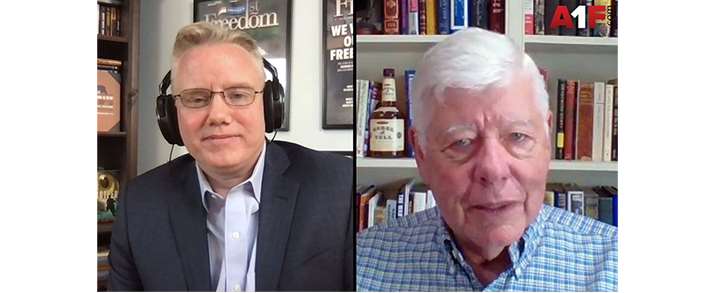
In many ways, the threat gun owners face today is more dangerous than the one they confronted in 1968 or during the Clinton or Obama administrations. President Biden means to deliver on his promise to defeat the NRA, and his friends in Congress have vowed to pack the U.S. Supreme Court, if necessary, to repeal by judicial fiat, the protections guaranteed by the Second Amendment. They want to eliminate some of the most-widely owned firearms in the country, or make owning, manufacturing or buying them prohibitively expensive. They want what they call “universal background checks” and a ban on the sale of any firearm-related parts on the internet. They want to expand the categories of men and women included on the list of those prohibited from purchasing or owning any firearm, to repeal concealed-carry laws and to create a national firearms registry.
Driven by their quasi-religious dream of a gun-free utopia, they have advantages they did not have during those previous assaults on the Second Amendment. The media, both legacy and social, seem willing to do all they can to shut down gun owners and to prevent the debate that has in the past reminded the public and elected officials alike that the gun-controllers’ proposals make little sense.
However, the same obstacles that have prevented them from achieving their goals in the past will prevail again. The U.S. Constitution, the millions of NRA members and the tens of millions the NRA will reach during the months ahead will once again carry the day. The NRA has responded to the challenges facing gun owners against tremendous odds over the years and has grown stronger, learned from its setbacks and adopted strategies to counter new threats as they have developed.
Opponents of the right of free Americans to own firearms are not going away, and that fact alone makes the NRA as important to gun owners as ever before. NRA members, those who look to the NRA for leadership in defending their rights and those who would deprive them of those rights all understand this simple fact.
The NRA’s founders in 1871 may not have foreseen the political importance of the organization they created, but we owe them our gratitude because, without the NRA, America today would not be the nation they wanted to pass down to succeeding generations.
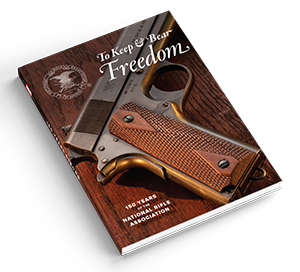 To preserve and win back our Second Amendment freedoms, we need to know the history behind it. To help, NRA Publications produced a book titled To Keep & Bear Freedom: 150 Years of the National Rifle Association. To order, call 1-866-672-2020.
To preserve and win back our Second Amendment freedoms, we need to know the history behind it. To help, NRA Publications produced a book titled To Keep & Bear Freedom: 150 Years of the National Rifle Association. To order, call 1-866-672-2020.

